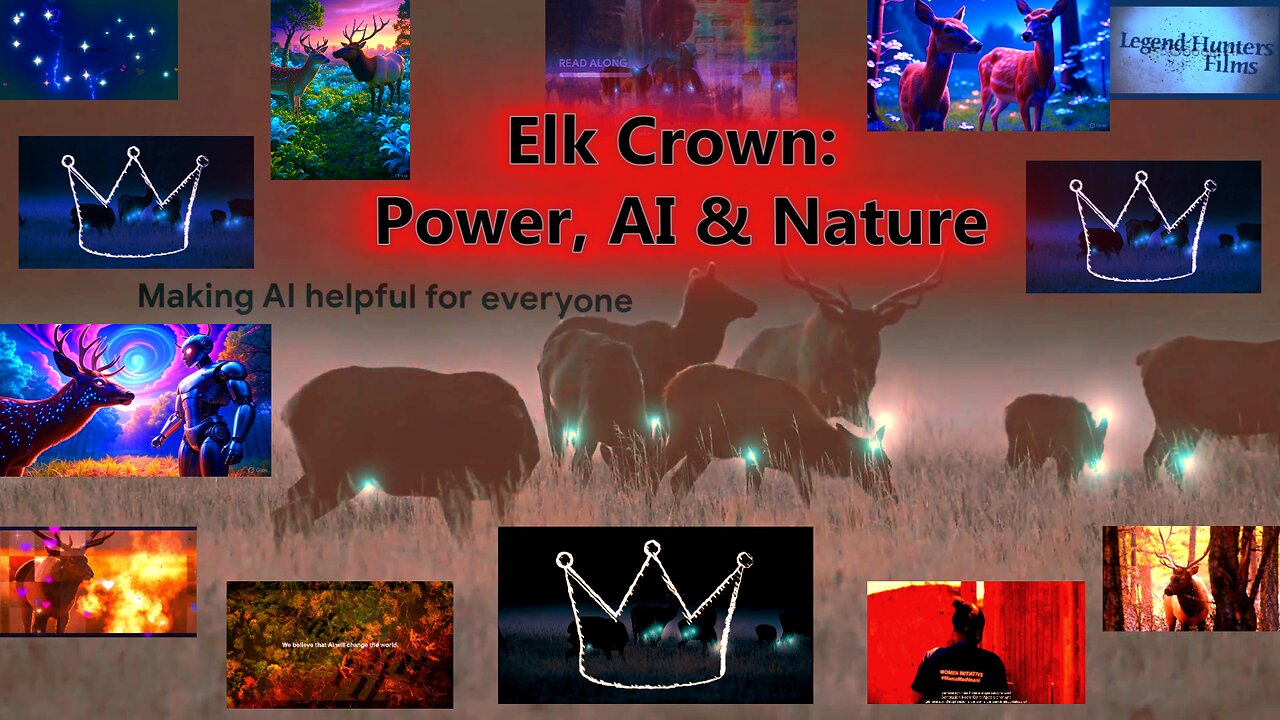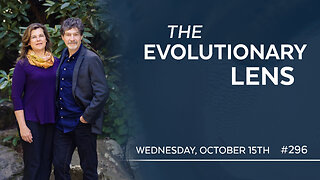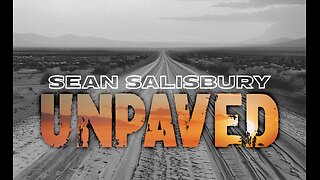Premium Only Content

Elk Crown . Power, AI & Nature . Flashing lights
Battle for the Crown – Where Elks, AI, and the Economic Crash Dance
Welcome to a dystopian-satirical journey that combines Gerald Celente's apocalyptic warnings, Google's brilliant AI dreams, and the unshakeable serenity of an Elk family in an artistic whirl!
Prologue: Celente's Cassandra Call
The film opens with a four-minute firework from Gerald Celente's interview (dlive.tv/Oracio), in which the trend guru dissects the financial world with his distinctive voice: "Office real estate crisis? Check! Bank collapse? Check! AI bubble like the dotcom crash? Oh, absolutely!" Citing the 54% office space vacancy rate and expiring leases, he predicts an economic tsunami that will shake the markets in 2025 – including a déjà vu of the 2008 crash.
Interlude: Google's AI Utopia
The film transitions seamlessly to Google's visionary campaign. The YouTube clip praises AI as the savior of humanity – from environmental problems to education. But the satire-filled editing with robot voices and slight slow-motion makes Google's lofty claim seem like an overly optimistic advertisement from a retro future. "AI conquers the crown!" seems to be the message, but the connection to the battle for the crown becomes clear: Who holds the power – the moose or the algorithms? Published exclusively on Rumble to give Google a mischievous wink.
Main Act: The Elk Trailer Movie
The core of the film unfolds in a majestic homage to the elk, whose "battle for the crown" is accompanied by 80% AI-generated music. The scenes depict epic battles for dominance in the wild, interspersed with subtle references to Celente's warnings ("the markets are crashing, but the elk keep fighting!") and Google's AI vision ("algorithms don't graze, elk do!"). The AI music carries the drama, while the elk strut across the pastures in majestic tranquility.
The film ends in a poetic tableau: a peaceful elk family grazes in a sun-drenched meadow, while a starburst effect bathes the scene in an otherworldly light. The calypso music from the Google segment returns briefly to underscore the irony: As the global economy falters and AI "saves" humanity, the moose remain unfazed – the true kings of the crown,
while the moose remind us that nature always has the final say.
Call to Action: Watch this film on Rumble, share it with friends, and ask yourself: Who wears the crown – AI, capital, or the moose?
Pair it with a coffee from https://1775coffee.com/ – perfect!
--
Sources as far as known: via YouTube
Gerald Celente, @gcelente, United States
Joined on October 25, 2007
242,000 subscribers
1,522 videos
Our excerpt found at dlive.tv/Oracio
--
How we're making AI helpful for everyone, July 24, 2023
Let's make a difference with responsible AI for social good. Here's how we're using AI to fight deforestation, emissions, climate change, diabetes, and improve communication.
www.youtube.com/@Google
Joined September 19, 2005
13.2M subscribers
2,303 videos
4,460,382,989 views
--
Elk Country ,Trailer movie,
Nestled in the heart of the Keystone State, the rugged hills and dense forests of Pennsylvania are home to one of the most magnificent and awe-inspiring animals—the wild elk. Join us on a journey into Pennsylvania's Elk Country.
IMDb 3.1
51 minutes
2025
16+
Documentary
e.g., on: primevideo.com, amazon.co.uk
More info
Content Advisory:
Flashing lights, flashing lights, and strobe patterns may affect light-sensitive viewers!!!
Subtitles
None available
Directors
Ryan Cavalline
Producer
Ryan Cavalline
Cast
Jim Hanemaayer
Studio
Filmhub
--
Moose (Cervus canadensis) are a fascinating success story of the conservation movement in Pennsylvania. After they were extinct in PA in the 19th century, they were reintroduced in 1913. Today, about 1,000–1,500 moose live in the northern and central regions of the state, primarily in Elk, Cameron, Clearfield, and Clinton counties. The Pennsylvania Game Commission manages the population, and the animals are particularly well-known in the area around Benezette, where there is an Elk Country Visitor Center.
1. Habitat: Moose prefer the wooded hills and meadows of the Allegheny Mountains. They feed on grasses, bark and twigs and are particularly active at dawn and dusk.
2. Behavior: Autumn (September–October) is the rutting season, when males (bulls) compete for supremacy (and females) with loud roars and fights. The bulls have impressive antlers that can grow up to 1.5 meters wide.
3. Population: Hunting is strictly regulated, with a limited number of licenses per year (e.g. 144 in 2023). Moose are a tourist attraction, and looking at the animals ("Elk Viewing") is very popular in PA.
What do 6, 10, or 12 points mean on elk antlers?
The "points" (also called "rungs" or "points") refer to the number of antler points on a bull elk. In elk (especially the American elk, Alces alces, as in your film from Elk County, Pennsylvania), the antlers are an important characteristic:
6 points: Antlers with 6 points (i.e., 3 points per side) often indicate a younger or smaller bull. This could be a 2- to 3-year-old elk just reaching sexual maturity.
10 points: A 10-point antler (5 points per side) indicates a mature, powerful bull, typically 4 to 6 years old, in his prime. Such antlers are impressive and signal strength and dominance in the "battle for the crown."
12 or more points: A 12-point bull (6+ points per side) is a true gem, often an older bull (6-8 years or older) who is at the top of the hierarchy. These elk are rare and considered the "kings" of the herd.
Can you determine the age of elk by their points?
Not directly, but there is a rough correlation:
Young elk (1-2 years): Often only small "spikes" or antlers with 2-4 points, as they are still growing.
Adult elk (3-6 years): Antlers become larger and more complex, with 6-10 points, depending on nutrition, genetics, and health.
Older elk (7+ years): They can have 12 or more points, but in very old bulls (10+ years), the antlers may shrink again as physical performance declines.
Important note: The number of antlers depends not only on age, but also on factors such as diet, genetics, and environment. A well-nourished 4-year-old elk in Pennsylvania might have larger antlers than a 7-year-old elk in a food-poor region. To accurately determine age, wildlife biologists often look at teeth (tooth wear) or other physical characteristics.
that's all!
-
 1:26:01
1:26:01
The Quartering
2 hours agoYoung Republican Smear, Woke Sidewalks Washed Away, Major Changes To X & More
75.5K31 -
 LIVE
LIVE
Dr Disrespect
5 hours ago🔴LIVE - DR DISRESPECT - BATTLEFIELD 6 - THE PERFECT WEAPON
1,561 watching -
 LIVE
LIVE
Darkhorse Podcast
3 hours agoThe 296th Evolutionary Lens with Bret Weinstein and Heather Heying
292 watching -
 LIVE
LIVE
StoneMountain64
48 minutes agoI can't stop playing BATTLEFIELD 6
35 watching -
 LIVE
LIVE
Jeff Ahern
1 hour agoNever Woke Wednesday with Jeff Ahern
135 watching -
 1:24:59
1:24:59
Sean Unpaved
4 hours agoPrime Pulse: Yamamoto's Gem, Mendoza & Simpson's Title Quest, & NFL QB Rule Shift
23.3K1 -
 2:38:53
2:38:53
The Shannon Joy Show
5 hours agoCharlie Kirk Killing Exploited For Trump’s Everything War - Insurrection Against The Constitution
28.6K13 -
 10:54
10:54
Midwest Crime
3 hours agoTrain Platform Killer Caught on Camera
7.02K1 -
 10:02
10:02
China Uncensored
3 hours agoChina Has LOTS of Regret
7.87K13 -
 30:39
30:39
The Boomer Effect
4 hours agoBurnout Is Not a Badge: Redesign Your Life
4.84K